HAMMERTOES
Posted February 06, 2017 in Hammertoes

If I were to create a list of the top 3 complaints I hear from patients when they come to the office it would be: bunions, hammertoes, and heel pain. We’ve already tackled bunions so let’s explore hammertoes.
Some common questions you might have when pondering your hammertoes: what is a hammertoe? What causes it? Can I blame grandma? What can I do to be pain free?
A hammertoe is a deformity of the second, third, fourth, and/or fifth toes. The middle joint of the toe (also called the proximal interphalangeal joint) begins to bend downward. The resulting deformity starts to loosely resemble a hammer. There are a few variations of hammertoes depending on where the bend is located. For example, a mallet toe is a bend in the joint closest to the toenail (the distal interphalangeal joint). A bend in both the middle and end joints is called a claw toe. Regardless of the type of hammertoe, the causes (and treatments) are very similar.
So, can you blame your mom, dad, or grandparents for the hammertoe that is preventing you from getting into those nice pair of shoes? Unfortunately, it may the nice pair of shoes that caused the hammertoe. Hammertoes are a result of muscle imbalance brought on by ill-fitting shoes along with a couple other factors. Narrow shoes and high heels change or restrict the pull of the muscles that help straighten and bend the toe the correct amount. Over time the muscles shorten causing a contracture of the toe. Left untreated, corns and calluses may develop on the top of the toes or bottom of the feet. After a prolonged period of neglect, the toe may become rigid and fixed in the hammered position, requiring surgery.
What can you do for these pesky painful piggies? Treatments for the condition typically involve wearing shoes with a wider toe box, doing toe exercises, physical therapy, and using toe strappings or cushions. It’s important to understand that these conservative methods cannot reverse or straighten the hammertoe once it’s started to form but it often can slow down or arrest it from worsening. If you’ve tried all of the above and it’s still bothering you, then you should consider discussing surgical options with your doctor.
Up next: heel pain. Stay tuned.
Interested in having your hammertoe evaluated? Feel free to email or call our office for a consultation.
